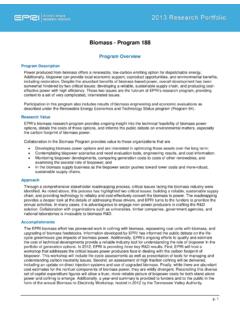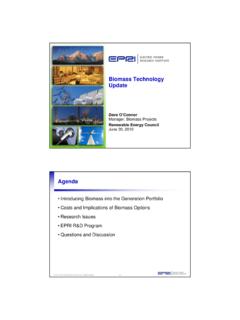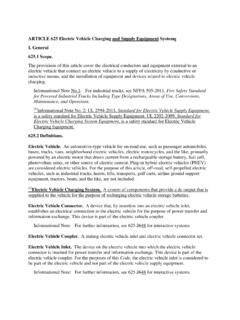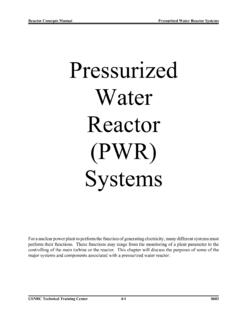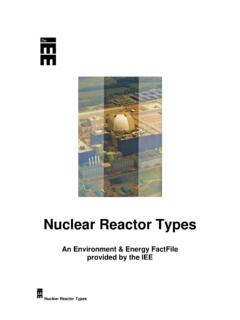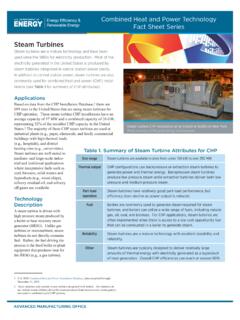Transcription of Steam Turbine-Generator Overhaul and Inspection Guidelines
1 Steam Turbine-Generator Overhaul and Inspection Guidelines EPRI product number 10141342 Copyright Electric Power Research Institute 2008 Overview Comprehensive Guidelines addressing Steam Turbine-Generator inspections and maintenance overhauls Critical industry review of all content, from written specifications to supporting software Annual updates reflecting industry operating experience, new technology and R&D advances Guidelines applicable at nuclear and fossil power plants worldwide3 Copyright Electric Power Research Institute 2008 Unique Elements Portable graphics All charts, graphics, tables can be extracted for use in plant-specific procedures, manuals, reports, etc. Templates Sample outage report 17 condition assessment data sheets 155 component-specific data sheets RFQs (requests for quote) for equipment procurement Foreign material exclusion (FME)
2 Guidance Training support Reference material for in-plant training and education of new personnel Modular approach4 Copyright Electric Power Research Institute 2008 Guideline Contents Seven volume, four CD set Volume 1 contains general guidance on planning and conducting Turbine-Generator maintenance overhauls and inspections Volumes 2-7 contain underlying technical guidance and tools supporting maintenance and overhaulsVolumeContent1 General Practices2 Repair Procedures3 Balancing and Alignment4 Component Procurement Specifications5 Engineering Database for Large Steam Turbines6/7 Blade/Disk Design Audit and Inspection Procedures5 Copyright Electric Power Research Institute 2008 What s New?2007 Updates Generator/exciter grinding procedure (Vol. 2) turbine blade tuning criteria (Vol.)
3 4) Excitation system purchase specification, with sample purchase RFQ (Vol. 4) turbine bolting purchase specification, with sample purchase RFQ (Vol. 4)Planned 2008 Updates Generator hydrogen seal best practices (Vol. 2) turbine grit blasting procedure (Vol. 2) Updated commutator/collector ring procedure (Vol. 2) Turbine-Generator alignment best practices (Vol. 3)6 Copyright Electric Power Research Institute 2008 Where to Find It QuestionVolumeHow do I determine which vendor is best for my needs?1 What should I do to assess my unit before an outage?1 What should I do to assess my unit during an outage?1 How do I establish an effective outage plan and schedule?1 How do I repair a collector ring or turbine diaphragm?2 What precautions should I take in selecting and monitoring a vendor s repair work?
4 2 What documentation should I request from a vendor for a specific repair activity?27 Copyright Electric Power Research Institute 2008 Where to Find It (continued)QuestionVolumeWhat are the advantages of high-speed vs. low-speed balancing?3 How can misalignment affect unit operation?3 What shim pad adjustments are needed to re-align my turbine rotor?3 What could be causing vibration levels to exceed design specifications?3 What information should I require from vendors in bid documents?4 What types of penalty clauses should I include when purchasing new equipment?4 What quality control checks should I require of vendors for new equipment?48 Copyright Electric Power Research Institute 2008 Where to Find It (continued)QuestionVolumeAre there power plants near me that might have spare parts for my Turbine-Generator ?
5 5 What plants have experience with the turbine modifications I m planning for my next outage?5 How can I assess how much turbine blade run time I have left based on differing blade failure mechanisms? 6/7 Which regions of the turbine blading are most susceptible to stress corrosion cracking? 6/79 Copyright Electric Power Research Institute 2008 Volume 1 General Practices Overview Technical guidance for both on-line and off-line Turbine-Generator condition assessments Pre-outage planning and bidding guidance Task-oriented information addressing scaffolding, crane availability, lay-down area, safety, machine disassembly, special tools, etc. Unit shutdown best practices Identify methods to reduce time required to bring unit from full speed to turning gear operation Oil flushing best practices Techniques to reduce critical path time, such as flushing with minimal external piping and filtration Pre start-up checks and post-outage activities10 Copyright Electric Power Research Institute 2008 Sample Content, Vol.
6 1 In-Service Condition Assessment Enables plant to monitor Steam Turbine-Generator condition since last Overhaul Addresses 17 systems/components Identifies risk-related recommendations for future outage work (color-coded) Green: No perceived problems. System or component is expected to perform reliably until the next assessment. Blue: No specific immediate or intermediate action necessary, but the issue is significant enough to be monitored. Yellow: Work required at next convenient outage to avoid potential forced shutdown if not corrected. Red: A specific component or system needs immediate attention. High risk of failure, causing loss of unit for an extended Electric Power Research Institute 2008 Sample Content, Vol. 1 System/Component Data SheetsSeries System or Component Data Assembled and Reviewed 1 Maintenance History Summary Record of modifications and upgrades 2 Turbine-Generator Vibration Readings at minimum-maximum load, criticals 3 Bearing Metal and Oil Temperatures Readings at minimum-maximum load 4 Section Performance Parameters Readings at full load, valves wide open 5 Start-Up Operation Record of starts, trips, service hours 6 Steam Purity Frequency of tests, criteria, out-of-spec events 7 Lubricating Oil and EHC Analysis Particle counts, presence of contaminates 8 Pump Start Tests Frequency of tests, pressures, out-of-spec events 9 Valve Tightness Tests Frequency of tests, criteria, sticking events 10 turbine Trips and Tests Record of trips, results.
7 Consequences 11 turbine Monitoring Instrumentation Readings at minimum-maximum load, calibrations 12 Generator-Exciter Condition Readings, criteria, test results 13 Auxiliary System Operation Readings, criteria, test results 14 Visual Inspection Results HP, IP, LP inlets and exhausts 15 Checklist of Out-of-Limit Events Record of unit upsets, actions, and consequences 16 Current Maintenance Plan Record of inspections: last, next, frequency 17 Overall Condition Assessment Summary with recommended actions 12 Copyright Electric Power Research Institute 2008 CONDITION ASSESSMENT SUMMARYC omponent or SystemDegradationGood ConditionCommentsSevereSignificantSomeHP XP erformance down 1% - monitorIPXP erformance down - monitorLPXG eneratorXEnd windings may be loose. Vibration data has not been consistent.
8 ExciterXExciter needs balancing. Insulation is very low on bearing. Lube oil systemXParticle count far exceeds oil systemXVacuum values trending toward higher end of acceptable trip too high. CV crack and intercept points need systemXChloride count trending toward higher end of acceptable valves and main stop valves are sticky. Last inspected three years InstrumentationXRecommendations: Both the lubricating oil and valves require attention. Refer to data sheet #5 and #7 for details. Based on their condition, the unit needs a weekend shutdown as soon as possible. Work is also required on the exciter and turbine controls. Refer to data sheets #12 and #13 for details. The urgency is not immediate, but this will require action before the currently scheduled intervals listed for these systems.
9 Refer to sheet # Content, Vol. 1 Overall Condition Assessment Sheet13 Copyright Electric Power Research Institute 2008 Sample Content, Vol. 2 Repair Procedures Equally useful for on-site and off-site repairs Scope of Work Defines tasks to be performed by utility or vendor References/Test Requirements Defines prerequisites for the repair, such as materials needed, testing techniques, instructions for repair vendor Procedures Provides numbered steps, supported by checklists and graphics as necessary Administrative/Report Requirements Defines reports to be completed post-repair Includes data sheet templates to be completed by vendor14 Copyright Electric Power Research Institute 2008 Sample Content, Vol. 2 Example: Diaphragm Partition RepairsScope of Work (not comprehensive) Provide transportation to vendor repair facility.
10 Remove all diaphragm hardware, place in a bag of sufficient strength, and tag the bag with the plant name, unit number, and diaphragm stage. Grit blast diaphragm using 220-grit aluminum oxide or equivalent. Perform an incoming Inspection as outlined in Table 2-2. Perform a 100% diaphragm partition repair using 410 weld material, assuming a 5/8" cutback is required. Stress relieve the diaphragm as outlined in Table 2-4. Perform a final nondestructive evaluation/quality control, and record the diaphragm pitch, throat, and radial height data in Table 2-6. Perform a final outgoing Inspection as outlined in Table Electric Power Research Institute 2008 Sample Content, Vol. 2 Example: Diaphragm Partition RepairsReferences/Test Requirements (not comprehensive) Air gap on contour convex side: < " using a contour gauge.





